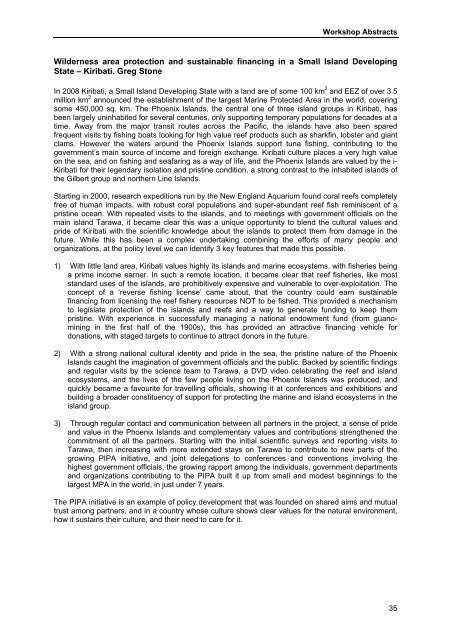Obura2009-IUCN Congress report - Resilience sessions
Obura2009-IUCN Congress report - Resilience sessions.pdf
Obura2009-IUCN Congress report - Resilience sessions.pdf
You also want an ePaper? Increase the reach of your titles
YUMPU automatically turns print PDFs into web optimized ePapers that Google loves.
Workshop Abstracts<br />
Wilderness area protection and sustainable financing in a Small Island Developing<br />
State – Kiribati. Greg Stone<br />
In 2008 Kiribati, a Small Island Developing State with a land are of some 100 km 2 and EEZ of over 3.5<br />
million km 2 announced the establishment of the largest Marine Protected Area in the world, covering<br />
some 450,000 sq. km. The Phoenix Islands, the central one of three island groups in Kiribati, has<br />
been largely uninhabited for several centuries, only supporting temporary populations for decades at a<br />
time. Away from the major transit routes across the Pacific, the islands have also been spared<br />
frequent visits by fishing boats looking for high value reef products such as sharkfin, lobster and giant<br />
clams. However the waters around the Phoenix Islands support tuna fishing, contributing to the<br />
government’s main source of income and foreign exchange. Kiribati culture places a very high value<br />
on the sea, and on fishing and seafaring as a way of life, and the Phoenix Islands are valued by the i-<br />
Kiribati for their legendary isolation and pristine condition, a strong contrast to the inhabited islands of<br />
the Gilbert group and northern Line Islands.<br />
Starting in 2000, research expeditions run by the New England Aquarium found coral reefs completely<br />
free of human impacts, with robust coral populations and super-abundant reef fish reminiscent of a<br />
pristine ocean. With repeated visits to the islands, and to meetings with government officials on the<br />
main island Tarawa, it became clear this was a unique opportunity to blend the cultural values and<br />
pride of Kiribati with the scientific knowledge about the islands to protect them from damage in the<br />
future. While this has been a complex undertaking combining the efforts of many people and<br />
organizations, at the policy level we can identify 3 key features that made this possible.<br />
1) With little land area, Kiribati values highly its islands and marine ecosystems, with fisheries being<br />
a prime income earner. In such a remote location, it became clear that reef fisheries, like most<br />
standard uses of the islands, are prohibitively expensive and vulnerable to over-exploitation. The<br />
concept of a ‘reverse fishing license’ came about, that the country could earn sustainable<br />
financing from licensing the reef fishery resources NOT to be fished. This provided a mechanism<br />
to legislate protection of the islands and reefs and a way to generate funding to keep them<br />
pristine. With experience in successfully managing a national endowment fund (from guanomining<br />
in the first half of the 1900s), this has provided an attractive financing vehicle for<br />
donations, with staged targets to continue to attract donors in the future.<br />
2) With a strong national cultural identity and pride in the sea, the pristine nature of the Phoenix<br />
Islands caught the imagination of government officials and the public. Backed by scientific findings<br />
and regular visits by the science team to Tarawa, a DVD video celebrating the reef and island<br />
ecosystems, and the lives of the few people living on the Phoenix Islands was produced, and<br />
quickly became a favourite for travelling officials, showing it at conferences and exhibitions and<br />
building a broader constituency of support for protecting the marine and island ecosystems in the<br />
island group.<br />
3) Through regular contact and communication between all partners in the project, a sense of pride<br />
and value in the Phoenix Islands and complementary values and contributions strengthened the<br />
commitment of all the partners. Starting with the initial scientific surveys and <strong>report</strong>ing visits to<br />
Tarawa, then increasing with more extended stays on Tarawa to contribute to new parts of the<br />
growing PIPA initiative, and joint delegations to conferences and conventions involving the<br />
highest government officials, the growing rapport among the individuals, government departments<br />
and organizations contributing to the PIPA built it up from small and modest beginnings to the<br />
largest MPA in the world, in just under 7 years.<br />
The PIPA initiative is an example of policy development that was founded on shared aims and mutual<br />
trust among partners, and in a country whose culture shows clear values for the natural environment,<br />
how it sustains their culture, and their need to care for it.<br />
35


















